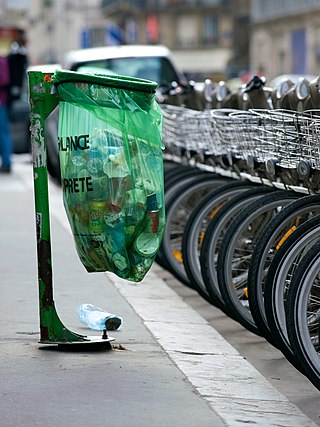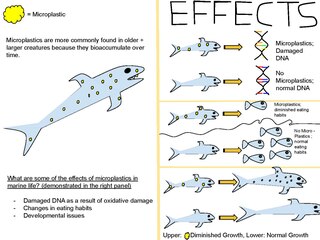Related Research Articles

Litter consists of waste products that have been discarded incorrectly, without consent, at an unsuitable location. The word litter can also be used as a verb: to litter means to drop and leave objects, often man-made, such as aluminum cans, paper cups, food wrappers, cardboard boxes or plastic bottles on the ground, and leave them there indefinitely or for other people to dispose of as opposed to disposing of them correctly.

A plastic bag, poly bag, or pouch is a type of container made of thin, flexible, plastic film, nonwoven fabric, or plastic textile. Plastic bags are used for containing and transporting goods such as foods, produce, powders, ice, magazines, chemicals, and waste. It is a common form of packaging.

Marine debris, also known as marine litter, is human-created waste that has deliberately or accidentally been released in a sea or ocean. Floating oceanic debris tends to accumulate at the center of gyres and on coastlines, frequently washing aground, when it is known as beach litter or tidewrack. Deliberate disposal of wastes at sea is called ocean dumping. Naturally occurring debris, such as driftwood and drift seeds, are also present. With the increasing use of plastic, human influence has become an issue as many types of (petrochemical) plastics do not biodegrade quickly, as would natural or organic materials. The largest single type of plastic pollution (~10%) and majority of large plastic in the oceans is discarded and lost nets from the fishing industry. Waterborne plastic poses a serious threat to fish, seabirds, marine reptiles, and marine mammals, as well as to boats and coasts.

Wildcoast is an international non-profit environmental organization that conserves coastal and marine ecosystems and wildlife.

The Great Pacific Garbage Patch is a garbage patch, a gyre of marine debris particles, in the central North Pacific Ocean. It is located roughly from 135°W to 155°W and 35°N to 42°N. Spanning from the western coast of North America to Japan.(Great Pacific Garbage Patch National Geographic 2023) The collection of plastic and floating trash originates from the Pacific Rim, including countries in Asia, North America, and South America.

Ocean Conservancy is a nonprofit environmental advocacy group based in Washington, D.C., United States. The organization seeks to promote healthy and diverse ocean ecosystems, prevent marine pollution, climate change and advocates against practices that threaten oceanic and human life.
A garbage patch is a gyre of marine debris particles caused by the effects of ocean currents and increasing plastic pollution by human populations. These human-caused collections of plastic and other debris, cause ecosystem and environmental problems that affect marine life, contaminate oceans with toxic chemicals, and contribute to greenhouse gas emissions. Once waterborne, marine debris becomes mobile. Flotsam can be blown by the wind, or follow the flow of ocean currents, often ending up in the middle of oceanic gyres where currents are weakest. Garbage patches grow because of widespread loss of plastic from human trash collection systems.

Marine plastic pollution is a type of marine pollution by plastics, ranging in size from large original material such as bottles and bags, down to microplastics formed from the fragmentation of plastic material. Marine debris is mainly discarded human rubbish which floats on, or is suspended in the ocean. Eighty percent of marine debris is plastic. Microplastics and nanoplastics result from the breakdown or photodegradation of plastic waste in surface waters, rivers or oceans. Recently, scientists have uncovered nanoplastics in heavy snow, more specifically about 3,000 tons that cover Switzerland yearly.

The North Atlantic garbage patch is a garbage patch of man-made marine debris found floating within the North Atlantic Gyre, originally documented in 1972. A 22-year research study conducted by the Sea Education Association estimates the patch to be hundreds of kilometers across, with a density of more than 200,000 pieces of debris per square kilometer. The garbage originates from human-created waste traveling from rivers into the ocean and mainly consists of microplastics. The garbage patch is a large risk to wildlife through plastic consumption and entanglement. There have only been a few awareness and clean-up efforts for the North Atlantic garbage patch, such as The Garbage Patch State at UNESCO and The Ocean Cleanup, as most of the research and cleanup efforts have been focused on the Great Pacific garbage patch, a similar garbage patch in the north Pacific.
Save Our Shores (SOS) is a marine conservation nonprofit dedicated to "foster thriving and sustainable ecosystems in the Monterey Bay and surrounding habitats through equitable environmental action.”

The Indian Ocean garbage patch, discovered in 2010, is a marine garbage patch, a gyre of marine litter, suspended in the upper water column of the central Indian Ocean, specifically the Indian Ocean Gyre, one of the five major oceanic gyres. The patch does not appear as a continuous debris field. As with other patches in each of the five oceanic gyres, the plastics in it break down to ever smaller particles, and to constituent polymers. As with the other patches, the field constitutes an elevated level of pelagic plastics, chemical sludge, and other debris; primarily particles that are invisible to the naked eye. The concentration of particle debris has been estimated to be approximately 10,000 particles per square kilometer.

A junk raft is a type of home-built watercraft made of plastic bottles or other recycled materials constructed by artists and community-minded groups organizing recreational flotillas, or by environmentally concerned individuals seeking to draw attention to the problem of floating debris and the need for recycling. It can also be an improvised small, functional watercraft from readily available materials.

Marina DeBris is the name used by an Australian-based artist whose work focuses on reusing trash to raise awareness of ocean and beach pollution. DeBris uses trash washed up from the beach to create trashion, 'fish tanks', decorative art and other works of art. She has also used beach trash to provide one perspective on what the earth might look like from space. As well as creating art from debris, DeBris also is a fund raiser for environmental organizations, and collaborates with non-profit organizations and schools to educate children about ocean pollution. In 2021, DeBris found almost 300 face masks on beaches, and used them in her trashion and other displays.

Plastic pollution is the accumulation of plastic objects and particles in the Earth's environment that adversely affects humans, wildlife and their habitat. Plastics that act as pollutants are categorized by size into micro-, meso-, or macro debris. Plastics are inexpensive and durable, making them very adaptable for different uses; as a result, manufacturers choose to use plastic over other materials. However, the chemical structure of most plastics renders them resistant to many natural processes of degradation and as a result they are slow to degrade. Together, these two factors allow large volumes of plastic to enter the environment as mismanaged waste which persists in the ecosystem and travels throughout food webs.

Ocean Recovery Alliance (ORA) is a 501c3 registered non-profit organization in California, and registered charitable organization in Hong Kong, with the aim to use new technologies, innovations, creativity and collaborations to solve issues that face the health of the ocean today.
The 5 Gyres Institute is a 501(c)(3) non-profit organization that focuses on reducing plastics pollution by focusing on primary research. Programs concentrate on science, education and adventure. Since 2017, 5 Gyres has been in special consultative status with the United Nations Economic and Social Council. The organization's 2015 Expedition was featured in the 2017 documentary "Smog of the Sea," produced by Jack Johnson, who participated in the voyage.

Boyan Slat is a Dutch inventor and entrepreneur. A former aerospace engineering student, he is the CEO of The Ocean Cleanup.

The Ocean Cleanup is a nonprofit environmental engineering organization based in the Netherlands that develops technology to extract plastic pollution from the oceans and to capture it in rivers before it can reach the ocean. Their initial focus was on the Pacific Ocean and its garbage patch, and extended to rivers in countries including Indonesia, Guatemala, and the United States.
4Ocean is a for-profit company founded in Boca Raton, Florida, in 2017. 4Ocean retails bracelets made from recycled materials, as well as apparel and other merchandise for which the materials are environmentally- and socially responsibly sourced.

National CleanUp Day is held annually in the United States and globally on the third Saturday of September. In the United States, there are cleanups held in every State and Territory. It promotes country-scale organized and individual cleanup events and volunteering to keep the outdoors clean and prevent plastic from entering the ocean. National CleanUp Day is organized by Clean Trails, a nonprofit organization founded by Bill Willoughby and Steve Jewett.
References
- ↑ "Clean Oceans International". HydroHeart. Retrieved 2020-07-24.
- ↑ Hamel, Jessi (2011-04-20). "From Trash to Fuel". Good Times Santa Cruz. Retrieved 2020-07-24.
- ↑ "Turning the Ocean's Plastic Into Fuel". www.kazu.org. Retrieved 2020-07-24.
- ↑ "Clean Oceans International". HydroHeart. Retrieved 2020-07-24.
- ↑ Hamel, Jessi (2011-04-20). "From Trash to Fuel". Good Times Santa Cruz. Retrieved 2020-07-24.
- ↑ "Turning the Ocean's Plastic Into Fuel". www.kazu.org. Retrieved 2020-07-24.
- ↑ "The Response". The Clean Oceans Project. Retrieved 24 April 2014.
- ↑ Jennings, Cheryl. "Radar used to monitor currents in the bay". KGO-TV. Archived from the original on 25 April 2014. Retrieved 24 April 2014.
- 1 2 Fairchilds, Kirsten. "Annie Morhauser, Annieglass to host Clean Oceans Project talk". Santa Cruz Sentinel. Archived from the original on 25 April 2014. Retrieved 24 April 2014.
- ↑ "Santa Cruz Harbor: Businesses Listings". Santa Cruz Port District (Santa Cruz, California). Archived from the original on 25 April 2014. Retrieved 24 April 2014.
- ↑ Mosko, Sarah. "Mid-Ocean Plastics Cleanup Schemes: Too Little Too Late?". E-The Environmental Magazine. Archived from the original on 12 December 2013. Retrieved 25 April 2014.
- 1 2 "Jim Holm: The Clean Oceans Project". TEDxGramercy. Archived from the original on 10 December 2013. Retrieved 24 April 2014.
- ↑ Hamel, Jessi. "From Trash to Fuel". Santa Cruz Good Times. Archived from the original on 25 April 2014. Retrieved 24 April 2014.
- ↑ West, Amy E. "Santa Cruz nonprofit hopes to make fuel from ocean-based plastic". San Jose Mercury News. Retrieved 24 April 2014.
- ↑ Corby, Rhiannon. "Ocean dump cleanup: Nonprofit has plans for 4-million ton trash trap off Santa Cruz coastline". Monterey Herald. Archived from the original on 25 April 2014. Retrieved 24 April 2014.
- ↑ "ABC & NBC News Feature Collaborative Plastic Pollution Recovery Project to Save Sea Turtles". Turtle Island Restoration Network. Retrieved 24 April 2014.
- ↑ Merrill, Ph.D., Michelle Y. "Flex Week Activities: Responding to Plastics in Our Oceans & Our Inner Otters". Cabrillo GreenSteps Blog. Archived from the original on 25 April 2014. Retrieved 24 April 2014.